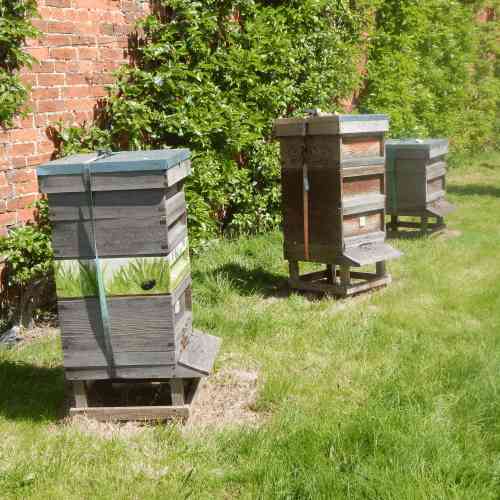Where Do Bees Live?
Uploaded: 4th January 2024
Bees live in a wide variety of places, and some species are surprisingly adaptable. Whilst some species may construct a nest from scratch, others make use of man made structures, whether they were deliberately intended to provide homes for bees or not.
Where do bees live? It depends on the species of course!
Generally speaking, most bee species make use of aerial crevices, holes or caverns in various locations, whilst others may nest under ground.
Let's take a look at broad requirements of species.
Where do bumble bees live?
Bumble bees, depending on type, tend to nest either:
 This bumble bee nest was created by making use of a hole caused by uprooted tree trunks. The pink circle highlights a bumble bee worker close to the nest.
This bumble bee nest was created by making use of a hole caused by uprooted tree trunks. The pink circle highlights a bumble bee worker close to the nest.- under ground, usually in abandoned rodent holes, or crevices caused by tree roots or similar
- some species, notably carder bumble bees, nest in the open, usually on tussocks of grass
- aerial nests, usually in crevices of trees, holes in walls, or other 'mini-caves'. As such, many will happily make use of man made cavities, such as bird houses, compost heaps, or loft spaces.
Below is a video of a bumble bee nest in our compost bin. With this particular species - the tree bumble bee, Bombus hypnorum, males fly gather around the nest entrance in a 'drone cloud', but this is not the case for other bumble bee species.
Where do honey bees live?
 A honey bee nest was discovered in this tree trunk and is marked by the arrow.
A honey bee nest was discovered in this tree trunk and is marked by the arrow.
In the wild, honey bees make their nests in large cavities, usually hollow tree trunks or even in caves.
You can read more about a wild honey bee nest I discovered and wrote about here.
I recorded honey bees living inside the same tree trunk for several years, at least until 2023.
Honey bees will also make use of man-made structures, such as chimneys, and of course, bee hives.
 Honey bees will happily make use of beehives in which to raise their colonies. Many different designs are available.
Honey bees will happily make use of beehives in which to raise their colonies. Many different designs are available.
Where do solitary bee species live?
 This painted mining bee had dug a nest burrow in a woodland location.
This painted mining bee had dug a nest burrow in a woodland location.There are thousands of solitary bee species, and as such, there is variation in specific nest sites, materials and the locations chosen, but nests tend to fall into general types:
- tunnels created underground, and burrowed by the female bee. This kind of nesting behaviour is typical of the mining bee species, for example the heather mining bee, Andrena fuscipes.
- tunnels created above ground, perhaps in wooden structures, or chewed into walls. Below is an image of nest tunnels and chambers chewed into a plank of wood by a carpenter bee.
 Carpenter bee nest tunnels chewed into a plank of wood with the remains of the chamber walls still visible.
Carpenter bee nest tunnels chewed into a plank of wood with the remains of the chamber walls still visible.- nests made in pre-existing 'tunnels' or cavities, such as hollow plant stems, holes vacated by other insects (often beetles), or even snail shells.
In the videos below, a red-tailed mason bee, Osmia bicolor makes a nest inside an empty snail shell, after which she creates a thatch over the shell, presumably to conceal it from predators and parasites.
|
Man-made structures may also be used, including specially made bee houses and hollow canes as in the image below, which features a bee house that has been occupied by red mason bees - Osmia bicornis.  Below you can see an unusual choice of location for a nest, made by a carpenter-mimic leafcutter bee, Megachile xylocopoides, in a bundle of letters in the office of a person's home. |
 A nest constructed with leaves inside a bundle of letters, with the female adult bee taking a segment of leaf to the nest for constructing cells.
A nest constructed with leaves inside a bundle of letters, with the female adult bee taking a segment of leaf to the nest for constructing cells.What do bees use to build their nests?
- Honey bees use pre-existing cavities, and inside it, they create hexagonal combs made from wax they make themselves.
- Bumble bees species that use pre existing holes may make use of pieces of dried grass, dried leaves and perhaps mouse hairs or dried matter they find inside the crevice.
Carder bees specifically use pieces of grass they gather together on a tussock of grass.
Read about bumble bee nests. - Other bee species use a variety of nesting materials.
For example:
Leafcutter bees typically use segments of leaf or petal for constructing and lining cigar-shaped nest cells.
Mason bees use mud, whilst resin bees gather resin with which they create their nests.
Wool carder bees line hollow twigs with hairs from plants, such as lamb's ear.
Do all bees sting?
If you found this page helpful or interesting, I'd really be grateful if you would share it with others - if not this page, perhaps another, such as Gardening For Bees.
Thank you so much :) .

